2018 Hyundai Kona maintenance schedule
[x] Cancel search: maintenance schedulePage 431 of 523
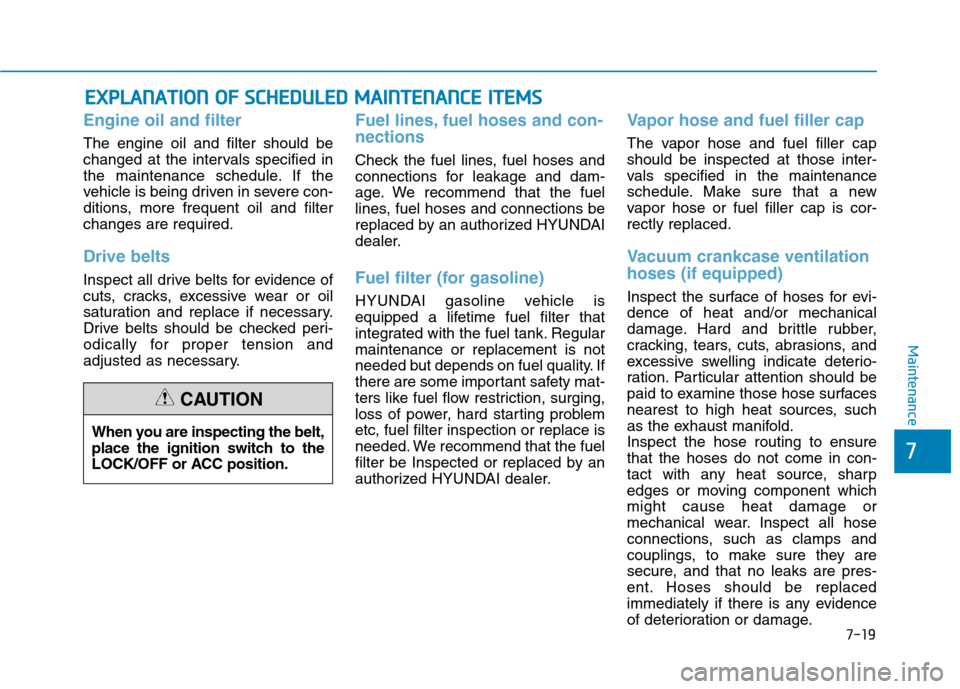
7-19
7
Maintenance
EEXX PPLLAA NN AATTIIOO NN OO FF SS CC HH EEDD UU LLEE DD MM AAIINN TTEENN AANN CCEE IITT EEMM SS
Engine oil and filter
The engine oil and filter should be
changed at the intervals specified in
the maintenance schedule. If the
vehicle is being driven in severe con-
ditions, more frequent oil and filterchanges are required.
Drive belts
Inspect all drive belts for evidence of
cuts, cracks, excessive wear or oil
saturation and replace if necessary.
Drive belts should be checked peri-
odically for proper tension and
adjusted as necessary.
Fuel lines, fuel hoses and con- nections
Check the fuel lines, fuel hoses and
connections for leakage and dam-
age. We recommend that the fuel
lines, fuel hoses and connections be
replaced by an authorized HYUNDAI
dealer.
Fuel filter (for gasoline)
HYUNDAI gasoline vehicle is
equipped a lifetime fuel filter that
integrated with the fuel tank. Regularmaintenance or replacement is not
needed but depends on fuel quality. If
there are some important safety mat-
ters like fuel flow restriction, surging,
loss of power, hard starting problem
etc, fuel filter inspection or replace is
needed. We recommend that the fuel
filter be Inspected or replaced by an
authorized HYUNDAI dealer.
Vapor hose and fuel filler cap
The vapor hose and fuel filler cap should be inspected at those inter-
vals specified in the maintenance
schedule. Make sure that a new
vapor hose or fuel filler cap is cor-rectly replaced.
Vacuum crankcase ventilation hoses (if equipped)
Inspect the surface of hoses for evi- dence of heat and/or mechanical
damage. Hard and brittle rubber,
cracking, tears, cuts, abrasions, and
excessive swelling indicate deterio-
ration. Particular attention should be
paid to examine those hose surfaces
nearest to high heat sources, such
as the exhaust manifold.Inspect the hose routing to ensurethat the hoses do not come in con-
tact with any heat source, sharp
edges or moving component whichmight cause heat damage or
mechanical wear. Inspect all hose
connections, such as clamps and
couplings, to make sure they are
secure, and that no leaks are pres-
ent. Hoses should be replaced
immediately if there is any evidence
of deterioration or damage.
When you are inspecting the belt,
place the ignition switch to the
LOCK/OFF or ACC position.
CAUTION
Page 432 of 523

7-20
Maintenance
Air cleaner filter
We recommend that the air cleaner
filter be replaced by an authorized
HYUNDAI dealer.
Spark plugs
(for Gasoline Engine)
Make sure to install new spark plugs
of the correct heat range.
Valve clearance
(for Gasoline Engine)
Inspect excessive valve noise and/or
engine vibration and adjust if neces-
sary. We recommend that the system
be serviced by an authorized HYUNDAI
dealer.
Cooling system
Check the cooling system parts,
such as radiator, coolant reservoir,
hoses and connections for leakage
and damage. Replace any damaged
parts.
Engine coolant
The coolant should be changed at
the intervals specified in the mainte-
nance schedule.
Manual transmission fluid (if equipped)
Inspect the manual transmission fluid according to the maintenance
schedule.
Dual clutch transmission fluid (if equipped)
Inspect the dual clutch transmission fluid according to the maintenance
schedule.
Brake hoses and lines
Visually check for proper installation,
chafing, cracks, deterioration and
any leakage. Replace any deteriorat-
ed or damaged parts immediately.
Brake/Clutch fluid (if equipped)
Check the brake/clutch fluid level in
the brake fluid reservoir. The level
should be between “MIN” and “MAX”
marks on the side of the reservoir.
Use only hydraulic brake fluid con-
forming to DOT 3 or DOT 4 specifi-cation.
Parking brake
Inspect the parking brake system
including the parking brake lever and
cables.
Do not disconnect and inspectspark plugs when the engine is
hot. You may burn yourself.
WARNING
Page 437 of 523
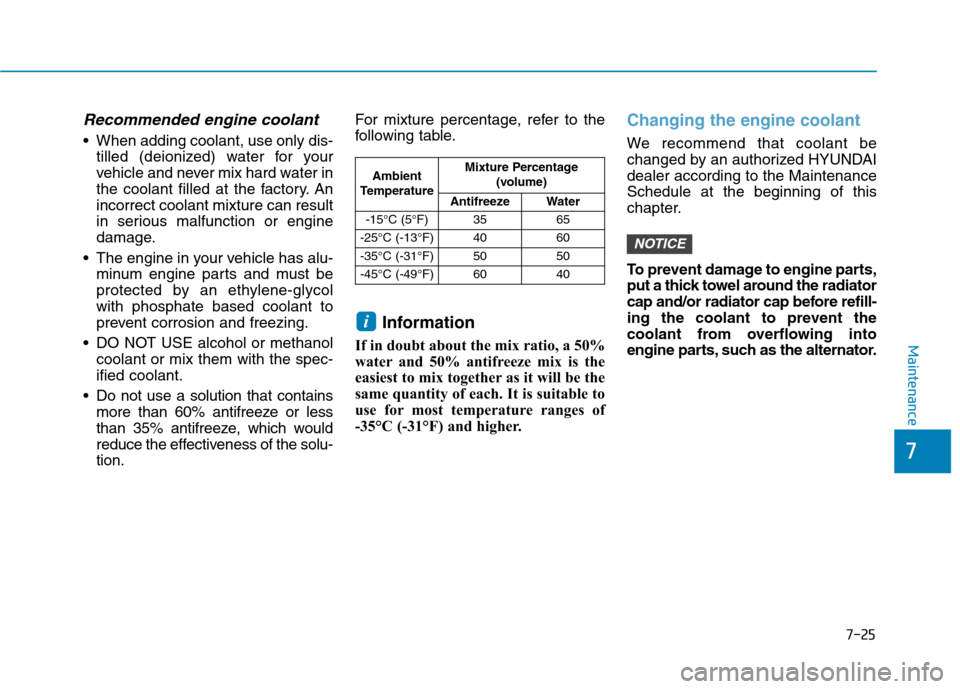
7-25
7
Maintenance
Recommended engine coolant
When adding coolant, use only dis-tilled (deionized) water for your
vehicle and never mix hard water in
the coolant filled at the factory. Anincorrect coolant mixture can result
in serious malfunction or engine
damage.
The engine in your vehicle has alu- minum engine parts and must be
protected by an ethylene-glycolwith phosphate based coolant to
prevent corrosion and freezing.
DO NOT USE alcohol or methanol coolant or mix them with the spec-ified coolant.
Do not use a solution that contains more than 60% antifreeze or less
than 35% antifreeze, which would
reduce the effectiveness of the solu-tion. For mixture percentage, refer to the
following table.
Information
If in doubt about the mix ratio, a 50%
water and 50% antifreeze mix is the
easiest to mix together as it will be the
same quantity of each. It is suitable to
use for most temperature ranges of
-35°C (-31°F) and higher.
Changing the engine coolant
We recommend that coolant be
changed by an authorized HYUNDAIdealer according to the MaintenanceSchedule at the beginning of this
chapter.
To prevent damage to engine parts,
put a thick towel around the radiator
cap and/or radiator cap before refill-
ing the coolant to prevent the
coolant from overflowing into
engine parts, such as the alternator.
NOTICE
i
Ambient
Temperature Mixture Percentage
(volume)
Antifreeze Water
-15°C (5°F) 35 65
-25°C (-13°F) 40 60
-35°C (-31°F) 50 50
-45°C (-49°F) 60 40
Page 441 of 523
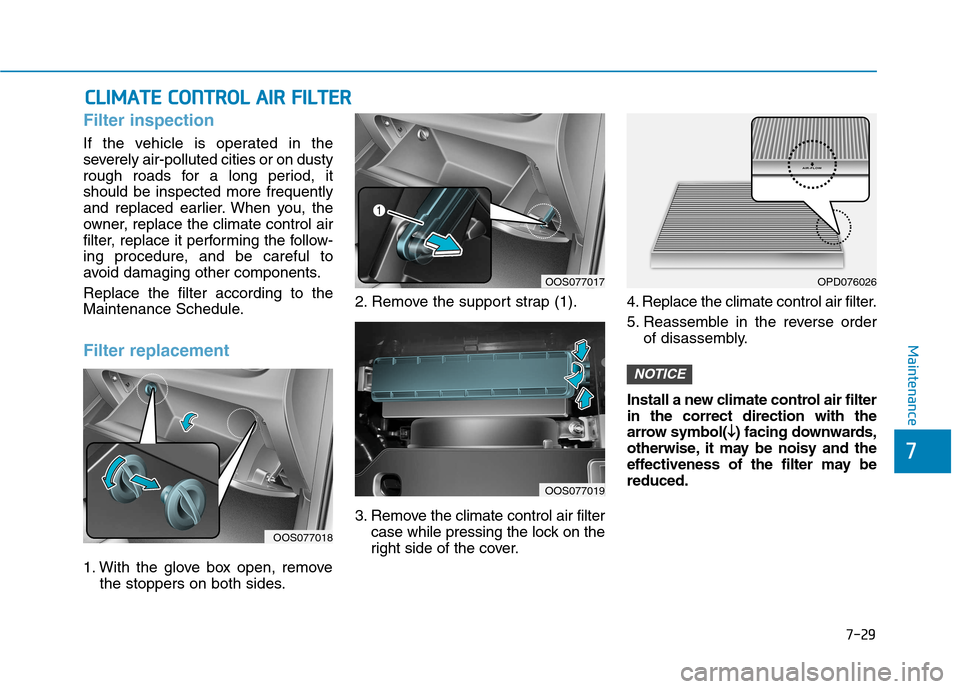
7-29
7
Maintenance
CCLLIIMM AATTEE CC OO NNTTRR OO LL AA IIRR FF IILL TT EERR
Filter inspection
If the vehicle is operated in the
severely air-polluted cities or on dusty
rough roads for a long period, itshould be inspected more frequently
and replaced earlier. When you, the
owner, replace the climate control air
filter, replace it performing the follow-
ing procedure, and be careful to
avoid damaging other components. Replace the filter according to the
Maintenance Schedule.
Filter replacement
1. With the glove box open, remove
the stoppers on both sides. 2. Remove the support strap (1).
3. Remove the climate control air filter
case while pressing the lock on the
right side of the cover. 4. Replace the climate control air filter.
5. Reassemble in the reverse order
of disassembly.
Install a new climate control air filter in the correct direction with the
arrow symbol( �
�
) facing downwards,
otherwise, it may be noisy and the
effectiveness of the filter may bereduced.
NOTICE
OOS077018
OOS077017
OOS077019
OPD076026
Page 497 of 523
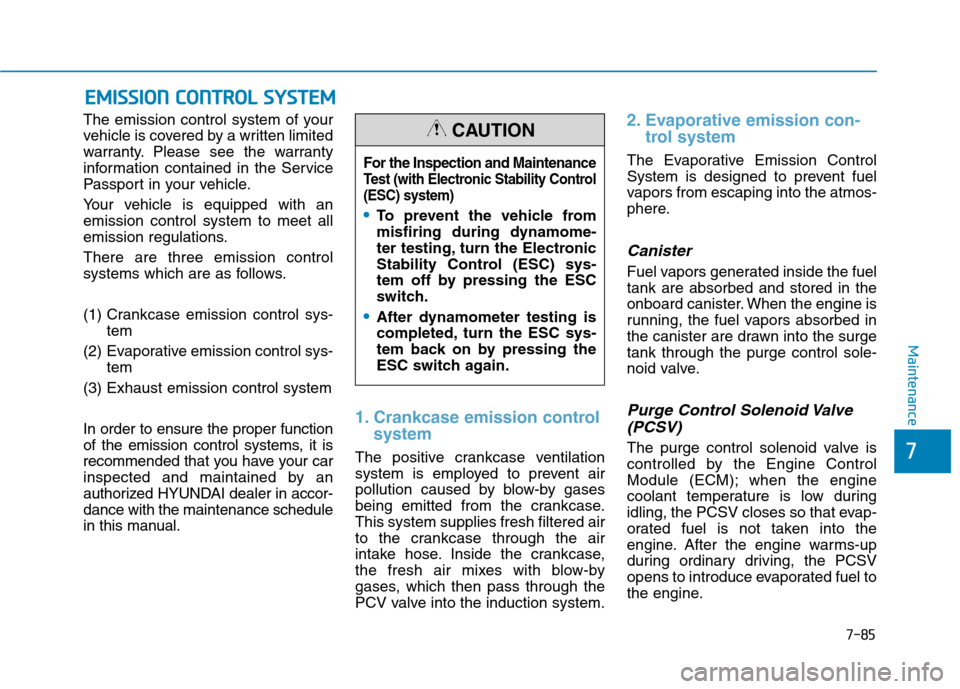
7-85
7
Maintenance
EEMM IISS SSIIOO NN CC OO NNTTRR OO LL SS YY SSTT EEMM
The emission control system of your
vehicle is covered by a written limited
warranty. Please see the warranty
information contained in the Service
Passport in your vehicle.
Your vehicle is equipped with an emission control system to meet all
emission regulations. There are three emission control
systems which are as follows.
(1) Crankcase emission control sys-
tem
(2) Evaporative emission control sys- tem
(3) Exhaust emission control systemIn order to ensure the proper function
of the emission control systems, it is
recommended that you have your car
inspected and maintained by an
authorized HYUNDAI dealer in accor-dance with the maintenance schedule
in this manual.
1. Crankcase emission control system
The positive crankcase ventilation
system is employed to prevent air
pollution caused by blow-by gases
being emitted from the crankcase.This system supplies fresh filtered air
to the crankcase through the air
intake hose. Inside the crankcase,
the fresh air mixes with blow-by
gases, which then pass through the
PCV valve into the induction system.
2. Evaporative emission con-trol system
The Evaporative Emission Control
System is designed to prevent fuel
vapors from escaping into the atmos-
phere.
Canister
Fuel vapors generated inside the fueltank are absorbed and stored in the
onboard canister. When the engine is
running, the fuel vapors absorbed in
the canister are drawn into the surgetank through the purge control sole-
noid valve.
Purge Control Solenoid Valve
(PCSV)
The purge control solenoid valve is
controlled by the Engine Control
Module (ECM); when the engine
coolant temperature is low during
idling, the PCSV closes so that evap-
orated fuel is not taken into the
engine. After the engine warms-up
during ordinary driving, the PCSV
opens to introduce evaporated fuel to
the engine.
For the Inspection and Maintenance
Test (with Electronic Stability Control(ESC) system)
To prevent the vehicle from
misfiring during dynamome-
ter testing, turn the Electronic
Stability Control (ESC) sys-
tem off by pressing the ESC
switch.
After dynamometer testing is
completed, turn the ESC sys-
tem back on by pressing the
ESC switch again.
CAUTION
Page 516 of 523

I-5
Engine compartment ...............................................1-8, 7-3
Engine compartment panel fuse replacement...............7-48
Engine coolant ..............................................................7-23
Engine coolant temperature gauge ...............................3-39
Engine number ..............................................................8-11
Engine oil......................................................................7-21
Engine specification .......................................................8-2
Engine start/stop button ..................................................5-9
Evaporative emission control System ..........................7-85
Exhaust emission control system .................................7-86
Explanation of scheduled maintenance items ..............7-19
Exterior care .................................................................7-78
Exterior overview ..........................................................1-2
Front view ..................................................................1-2
Rear view ...................................................................1-3
Floor mat anchor(s) ....................................................3-136
Fluid Brake/clutch fluid.....................................................7-26
Washer fluid .............................................................7-27
Forward Collision-Avoidance Assist (FCA) system ....5-63
Four Wheel Drive (4WD).............................................5-41
Front seat adjustment......................................................2-7 Manual adjustment .....................................................2-7
Power adjustment .......................................................2-9
Seatback pocket........................................................2-11
Adjusting the height up and down ...........................2-16 Forward and rearward adjustment ...........................2-16
Removal/Reinstall ....................................................2-17
Fuel filler door ..............................................................3-34
Fuel gauge.....................................................................3-39
Fuel requirements ...........................................................F-6
Unleaded ....................................................................F-6
Leaded ........................................................................F-7
Gasoline containing alcohol and methanol................F-7
Other fuels..................................................................F-7
Use of MTBE.............................................................F-8
Do not use methanol ..................................................F-8
Fuel Additives ............................................................F-8
Operation in foreign countries ...................................F-8
Fuses .............................................................................7-46 Instrument panel fuse replacement ..........................7-47
Fuse switch...............................................................7-48
Blade type fuse.........................................................7-48
Cartridge type fuse ...................................................7-48
Engine compartment panel fuse replacement ..........7-48
Main fuse..................................................................7-49
Multi fuse .................................................................7-49
Fuse/relay panel description ....................................7-50
Gauges and meters........................................................3-38
Glove box ...................................................................3-128
I
Index
F
G
Page 519 of 523

I-8Light bulbs ....................................................................7-64
Lighting.........................................................................3-83
Auto light position ...................................................3-83
Position lamp position..............................................3-84
Headlamp position ...................................................3-84
High beam operation ................................................3-84
High beam assist (HBA) ..........................................3-85
Turn signals ..............................................................3-88
Lane change signals .................................................3-88
Rear fog lamp...........................................................3-89
Battery saver function ..............................................3-90
Headlamp delay function .........................................3-90
Daytime running light (DRL) ..................................3-91
Headlamp leveling device ........................................3-91
Low Beam Assist-Static light...................................3-92
Low Beam Assist-Static light .......................................3-92
Lubricants and capacities ...............................................8-7
Luggage compartment lamp .........................................3-94
Luggage net (holder) ..................................................3-136
Luggage tray ...............................................................3-130
Main fuse ......................................................................7-49
Maintenance services......................................................7-4 Maintenance services .................................................7-4
Owner maintenance....................................................7-5
Scheduled maintenance services ................................7-7
Normal maintenance schedule ............................7-8, 13 Maintenance under severe usage conditions......7-11, 17
Explanation of scheduled maintenance items ..........7-19
Tire maintenance ......................................................7-41
Maintenance under severe usage conditions (for Europe) ................................................................7-11
Maintenance under severe usage conditions (except Europe) ..........................................................7-17
Manual climate control system...................................3-108
Manual transmission .....................................................5-16 Using the clutch .......................................................5-16
Downshifting ............................................................5-17
Good driving practices .............................................5-18
Manual transmission shift indicator .............................3-42
Mirrors ..........................................................................3-19 Day/night rearview mirror .......................................3-19
Electric chromic mirror (ECM) ...............................3-20
Inside rearview mirror..............................................3-19
Outside rearview mirror ...........................................3-20
Adjusting the outside rearview mirrors ...................3-21
Folding/Unfolding the outside rearview mirror.......3-22
Moonroof, see sunroof..................................................3-27
Multi box ....................................................................3-129
Multi fuse......................................................................7-49
Multimedia system .........................................................4-2 Aux, USB and iPod....................................................4-2
Antenna ......................................................................4-2
Steering wheel audio control .....................................4-3
Audio / Video / Navigation system............................4-4
Bluetooth ®
Wireless Technology hands-free .............4-4
Index
M
Page 520 of 523
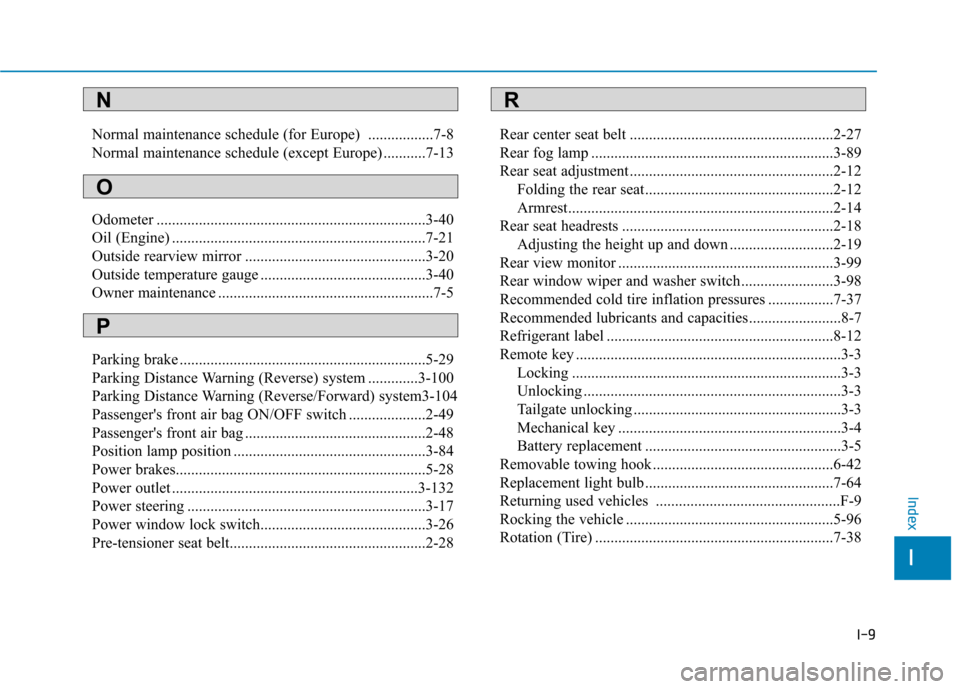
I-9
Normal maintenance schedule (for Europe) .................7-8
Normal maintenance schedule (except Europe) ...........7-13
Odometer ......................................................................3-40
Oil (Engine) ..................................................................7-21
Outside rearview mirror ...............................................3-20
Outside temperature gauge ...........................................3-40
Owner maintenance ........................................................7-5
Parking brake ................................................................5-29
Parking Distance Warning (Reverse) system .............3-100
Parking Distance Warning (Reverse/Forward) system3-104
Passenger's front air bag ON/OFF switch ....................2-49
Passenger's front air bag ...............................................2-48
Position lamp position ..................................................3-84
Power brakes.................................................................5-28
Power outlet ................................................................3-132
Power steering ..............................................................3-17
Power window lock switch...........................................3-26
Pre-tensioner seat belt...................................................2-28
Rear center seat belt .....................................................2-27
Rear fog lamp ...............................................................3-89
Rear seat adjustment .....................................................2-12
Folding the rear seat.................................................2-12
Armrest.....................................................................2-14
Rear seat headrests .......................................................2-18 Adjusting the height up and down ...........................2-19
Rear view monitor ........................................................3-99
Rear window wiper and washer switch........................3-98
Recommended cold tire inflation pressures .................7-37
Recommended lubricants and capacities........................8-7
Refrigerant label ...........................................................8-12
Remote key .....................................................................3-3 Locking ......................................................................3-3
Unlocking ...................................................................3-3
Tailgate unlocking ......................................................3-3
Mechanical key ..........................................................3-4
Battery replacement ...................................................3-5
Removable towing hook ...............................................6-42
Replacement light bulb .................................................7-64
Returning used vehicles ................................................F-9
Rocking the vehicle ......................................................5-96
Rotation (Tire) ..............................................................7-38
I
Index
N
O
P
R